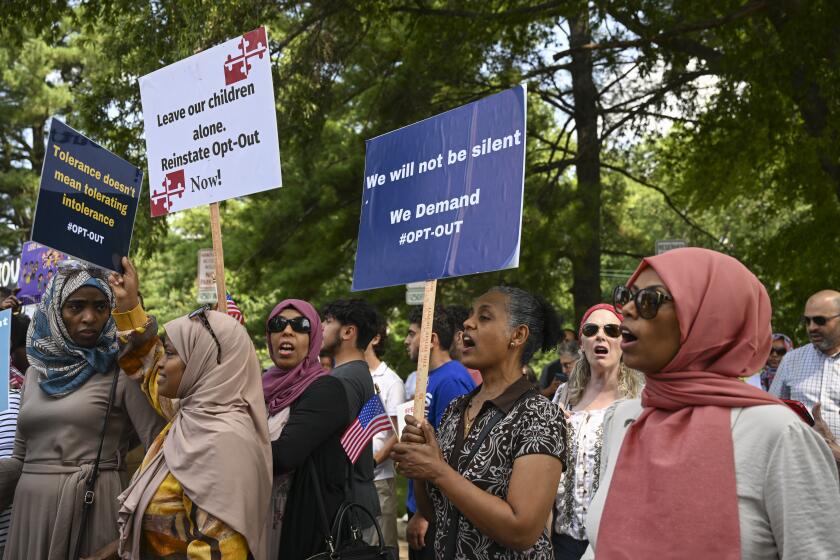Smoking Critics Seek Sweeping Restrictions on Ads for Cigarettes : Tobacco: Even the formidable industry lobby concedes that it will be unable to ward off some form of curbs. It calls one proposal ‘the ad ban bill from hell.’
- Share via
WASHINGTON — Congressional tobacco foes, emboldened by growing public concern about smoking, are launching an assault on cigarette advertising that could force the Marlboro Man to hang up his spurs.
Legislation that would prevent cigarette makers from using human models--those attractive young women and rugged men who dominate cigarette ads--is one of several sweeping proposals that are surfacing in response to intense criticism of tobacco companies’ marketing practices. Some in Congress are willing to spend more than $100 million to counter the ubiquitous advertisements with the government’s own message: Smoking kills.
The tobacco industry’s chief adversary on Capitol Hill, Rep. Henry A. Waxman, on Thursday introduced a wide-ranging measure so threatening to advertisers that one key marketing official has dubbed it “the ad ban bill from hell.”
“We’re going to the next stage of the smoking question in this country,” said the Los Angeles Democrat, who chairs the House subcommittee on health and the environment. “We are attacking the premise that, while smoking is legal, the federal government is helpless to try to stop the promotion and enlistment of new people to take up the habit.”
Meanwhile, a measure by Edward M. Kennedy (D-Mass.), which would provide $110 million to expand anti-smoking education through a federal Center for Tobacco Products, was sent to the Senate floor last month by the Labor and Human Resources Committee. The bill, which would fund public service television announcements and ads to discourage smoking, may be taken up by the full Senate next month. It, too, faces stiff industry opposition.
Ambitious legislative assaults on tobacco are nothing new. Most go nowhere.
These days, however, it is the $40-billion tobacco industry that is on the defensive--its vulnerability demonstrated by the recent enactment of a smoking ban on most domestic airline flights.
Twenty-six years after the first surgeon general’s report linked cigarette smoking and cancer, public concern about smoking has continued to mount. About 390,000 Americans die each year from smoking-related illnesses, according to the surgeon general, making smoking the nation’s leading preventable cause of death. And the Environmental Protection Agency is expected to soon propose classifying second-hand smoke as a confirmed human carcinogen, responsible for more than 3,000 lung cancer deaths a year among nonsmokers.
At the same time, Louis W. Sullivan, secretary of health and human services, has denounced cigarette marketing, particularly to minorities and young people, who he says are often the targets of the industry’s ads.
Congress last addressed cigarette advertising in 1984, passing a Waxman-sponsored bill that set up the current series of rotating labels that warn prospective buyers of the risks of cancer, heart disease, emphysema and possible harm to unborn babies.
Now, even some of tobacco’s staunch supporters believe added curbs on advertising are almost inevitable in this Congress or next.
“The mood of Congress is that it’s time to do some other things on the smoking and health issue . . . that there’s extreme concern about smoking among young people and the possible targeting of young people” by cigarette advertising, said Rep. Charlie Rose (D-N.C.), a champion of tobacco farmers.
About 90% of smokers take up the habit before the age of 21, according to HHS’s Office on Smoking and Health. Tobacco officials contend that it is peer pressure, not advertising, that prompts young people to smoke. They say their advertising is intended only to woo existing smokers from one brand to another.
The six major cigarette companies spent $3.27 billion in 1988 on advertising and promotion, according to a federal estimate.
Waxman’s omnibus bill--actually a compendium of anti-smoking measures introduced by colleagues--would bar use of models and prohibit cigarette sponsorship of sporting events and public entertainment.
Like the securities industry, cigarette makers would be limited to what is known in the trade as “tombstone” advertising--written text but no human figures or imagery, other than a picture of the cigarette brand.
In addition, the bill would increase the size of cigarette warning labels, add a warning that smoking is addictive and outlaw free samples. It would also withhold federal alcohol and drug-abuse funds from states that fail to adopt laws setting and enforcing a minimum age of 19 for cigarette purchases and prohibiting sales from vending machines accessible to minors.
“The premise is that the American population isn’t smart enough to see a picture of something and yet make their own decisions about whether they want to be smokers,” said Brennan Dawson, a spokeswoman for the Tobacco Institute, the industry lobbying group.
John O’Toole, president of the American Assn. of Advertising Agencies, said the bill is an advertising “ban in sheep’s clothing.” He said Waxman hopes to win indirectly the outright ban he could not achieve because of his colleagues’ free-speech concerns.
Once censorship starts, “it will just never end,” O’Toole said.
The Kennedy bill to finance an anti-smoking education and media campaign was initially the subject of negotiations between tobacco industry lobbyists and Kennedy’s Labor and Human Resources Committee. This, in itself, seemed to reflect industry recognition that further curbs may be unavoidable. However, the two sides failed to reach agreement and the tobacco lobby now opposes the measure.
“The average American is universally aware of the smoking and health allegations,” Dawson said. “You have to question whether you really need to spend $100 million a year on more of the same.”
Since the 1984 rotating labels bill, several other advertising measures have been pushed without success. The industry, along with its advertising and publishing allies, remains a formidable obstacle to sweeping restrictions.
In 1989 and the first quarter of this year, Philip Morris, R. J. Reynolds and the Tobacco Institute poured $771,929 into congressional races. Moreover, the tobacco companies and their allies in the billboard industry are two of the biggest dispensers of speaking fees to lawmakers, doling out $418,075 in 1989.
“They are pervasive, they sponsor everything under the sun and involve themselves in every aspect of political life in this town,” said Rep. Richard J. Durbin (D-Ill.), author of the airline smoking ban. “You cannot underestimate the political friendships they’ve established over the years that sustain them when they are under attack.”
Nevertheless, Rose, the tobacco-state congressman, said the industry is ready to accept more curbs on advertising “than the average House and Senate member probably realizes.”
But it won’t cave in to what it regards as unreasonable proposals, Rose added.
Industry supporters in Congress may forestall Waxman’s or Kennedy’s bills in this election-year session, when both sponsors are busy with other initiatives. Waxman, who has scheduled a July 12 hearing, faces a tough vote in his own subcommittee.
But the anti-smoking lawmakers say time is on their side.
“It would have been unthinkable 10 years ago, when I started in this area, that we would have been able to ban smoking on airline travel,” Waxman said. “But public opinion brought that about.”
More to Read
Get the L.A. Times Politics newsletter
Deeply reported insights into legislation, politics and policy from Sacramento, Washington and beyond. In your inbox twice per week.
You may occasionally receive promotional content from the Los Angeles Times.










